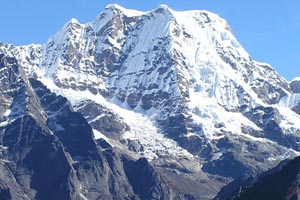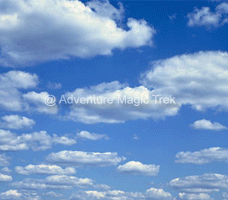
24 Hours Support Call
+977-9841570317 (Shankar Pandey)
email:info@adventurehikenepal.com
Mera Peak Climbing
 Mera Peak (6,654 m) is the highest permitted trekking peak of Nepal.It stands to the south of Everest and dominates the watershed between the heavily wooded valleys of the Hinku and Hongu Drangkas.
Mera Peak (6,654 m) is the highest permitted trekking peak of Nepal.It stands to the south of Everest and dominates the watershed between the heavily wooded valleys of the Hinku and Hongu Drangkas.
J.O.M. Roberts and Sen Tenzing made the first successful ascent of Mera Peak on 20 May 1953. The route they used is still the standard route. There are many other routes to the peak, but none of them are easy. Some of them require crossing very high and difficult passes. This leads to a true mountaineering experience. In the end, all efforts and hard work is paid off with spectacular scenery as Mera provides one of the finest viewpoints in Nepal. 
Mera Peak offers a panoramic view of Chamlang, Kangchenjunga, Makalu, and Baruntse in the east and the peaks of Cho-Oyu, Ama Dablam and Kangtega to the west. Everest can be viewed to the north over the massive unclimbed south face of Lhotse and the Nuptse/Lhotse ridge. Under favourable conditions, it is possible to climb the peak and descend back on the same day.
Day to Day Itinerary for Mera Peak climbing
Day 01: Arrival in Kathmandu
Flying to Kathmandu along the northern border of Nepal on a clear day is in itself an exciting and memorable experience as exotic panoramic view of snow-capped Annapurna mountain range peaks sprawls before you. The Nepali support team will meet you at the airport and escort you to your hotel.
Day 02:Sightseeing of Kathmandu Valley
Kathmandu, being a historical and cultural heart of Nepal, is a popular destination for tourists, trekkers and adventure seekers. The city presents a wonderful mixture of Hinduism, Tibetan Buddhism and Western influence in the Valley. Patan and Bhaktapur are its two major neighboring cities which bear immense historical, cultural and religious significance. There will be a half day guided tour to the famous & biggest Hindu shrine PASUPATHINATH, the largest Buddhist stupa in town BOUDHANATH, the 15th century palace of 55 windows and SOYAMBHUNATH. In the evening, a trip orientation meeting will be organized.
Day 03: Flight to Lukla [2850m]
We take an early morning flight to Lukla. During the flight, we can bask in the mesmerizing views of giant snow-capped mountain peaks. We will be camping for the night outside one of the many lodges.
Day 04:Trek to Chutanga [3050m]
On arriving at Lukla, we meet the trekking crew. We then head eastwards from Lukla. The trail crisscrosses through pristine hamlets and thick forest along Kalo Himal Ridge. We must stay aligned with our specific route. Otherwise, we may deviate from the target destination. At the time of winter, snow makes us transverse steep terrain. But during favorable climatic condition, the trail is usually straightforward. After 3-4 hours of trekking, we enter Chutanga.
Day 05: At Chutanga
We spend two memorable nights at Chutanga. This gives us sufficient time for acclimatization prior to confronting Zatrwa La. We can indulge in leisurely trek to a small 4000m peak below the Zatrwa Teng Pass. Excellent views unveil as we glimpse over the valley of the Dudh Kosi and the picturesque trail zigzagging towards Zatrwa La. After exploring, we descend back to our camp at Chutanga and succumb to complete relaxation.
Day 06:Trek to Tuli kharka [4300m]
The trail crosses the Kalo Himal Ridge which separates the Khumbu from the Hinku Valley. Further ahead, we transverse a comfortable path showcasing a cairned notch on the ridge with a collection of prayer flags at an elevation of 4450m. En route we may encounter yak herders. The views across the Dudh Kosi towards Karyolung and the Lumding Himal are very impressive and so is the view across the rolling foothills east of the Hinku Valley. Half an hour below the pass is a huge boulder which marks our campsite, Tuli Kharka. 6 to 7 hours of trekking finally take us to Tuli Kharka. NOTE: If conditions are particularly bad, we do have the option of crossing a lower pass to the south of the Zatrwa La, an alternative which involves 2 additional days of trekking.
Day 07:Trek to Mosum kharka [3700m]
The trail descends the rock-strewn path leading to a fine vantage point of the Hinku valley where mesmerizing views of the south face of Mera Peak become visible. The trail zigzags through forested areas and then descends steeply into the Hinku valley. Enchanting panorama of Peak 43 and Kusum Kangguru unfolds as we bask in the splendor of nature surrounding us from the Hinku Valley. We experience the most exotic and delightful feelings as we walk past forests of pine and rhododendron. Soon after reaching Mosum Kharka, we set a campsite by the banks of Hinku Drangka [river].
Day 08:Trek to Tangnag [4350m]
As we head to the west bank of the Hinku Khola northwards, forest blurs in and valley zooms out. We spot meadows being used as grazing areas for goats, sheep and yaks in the Upper Hinku. After several ascents for 4-6 hours, we approach summer settlement of Tangnag as we cross a single-plank bridge at Gondishung. We halt for lunch at this spot. Lying in its vicinity is 200 year-old gompa resting beneath a massive boulder and a number of crude mani walls. The trail offers an outstanding view of Peak 43.
Day 09:At Tangnag
We utilize two days getting completely acclimatized. After proper rest, we can explore other adventure possibilities like strolling by Sabal Tsho, beautiful moraine-dammed lake which is hidden behind the Sabal Glacier and climbing a peak up to an altitude of nearly 5000m. We can also explore Hinku Nup Glacier which leads north toward Kangtaiga. The upper Hinku valley turns to the east at Tangnag, crossing the moraine of the Dig Glaciers.
Day 10:Trek to Khare [5000m]
As we walk away from Tangnag, the trail ascends to a wide grassy basin, popularly called Dig Kharka. We continue walking for hours. After a while, we arrive at Khare. There are many campsites at Khare and the most popular one is at the upper end of Khare lying beneath a group of boulders. We choose this site for camping. This campsite offers splendid vistas of huge north face of Mera, Hinku Shar Glacier and Mera La.
Day 11:Khare upper end [5500m]
We use this day for acclimatization. After proper rest, we take a walk up to a small peak on the west side of the Hinku Nup Glacier, where we can reach a height of around 5500m. At this point, we get to capture stunning views of Mera La and Mera Peak.
Day 12: Trek up to campsite by lower part of Hinku Nup glacier
We follow the trail leading to Mera La. We continue transversing as far as the lowest part of the Hinku Nup Glacier. At this point, we get captivated by the exotic beauty of snow-slope and the panorama of Himalayan peaks.
Day 13:Rest day
This day has been specially set aside for giving us time to acclimatize completely and to have good rest. After relaxation, we get a further boost to lift up our adventure spirit.
Day 14:The ascent [6476m]
Early in the morning at around 2am after breakfast, we advance towards the summit. By sunrise we can reach up to 6000m. With Incessant attempts, we finally scale the summit. From the summit, we can embrace the most spectacular view of at least five of the world's fourteen 8000m peaks. Most of this spectacular panorama can be seen from the site of the high camp and all of it is visible from 6000m. After the climb, we descend to the campsite on the Hongu side of the pass.
Day 15-Day 18: Return back to Lukla
Day 16: Flight to Kathmandu
From Lukla, we take an early morning flight to Kathmandu.
Day 17: Depart Kathmandu
Our The Nepalese support team will take you to the airport for your flight home. (Or stay longer for short tours such as game drive at National parks, rafting, Tibet tours, mountain biking etc).
Cost Inclusive for Mera peak Climbing:
- Airport arrival and departure by private vehicle
- Deluxe twin sharing accommodation in Kathmandu
- All local transportation .
- Kathmandu to Lukla to Kathmandu both way flight tickets
- Meal on full board (breakfast, lunch, dinner, tea & coffee)basis during the trek
- Accommodation on tented camp during Climbing period
- Trekking/Mera peak Climbing peak permit/s & other necessary fees
- Necessary group climbing gear & equipments
- Climbing guide, cook & necessary Sherpa helper, all payments
- Gamow Bag( Portable altitude Chamber Bag) for safety measure on request
- Exclusive medical kit bag
- All government and local taxes
- Submit your tourist registration form to the require embassy/consulate
- Visa fees, intl. airfare & departure taxes
- Personal climbing equipment (can be hire in Kathmandu)
- Excess baggage charges
- Lunch and dinner in city
- Travel and rescue insurance
- Personal expenses e.g. phone calls, laundry, bar bills & extra porters
- Tips for driver, guides and porters
- Services doesn't includes in service inclusive column
| Enquiry | Book this Package | Tell a Friend | Print this Page |



